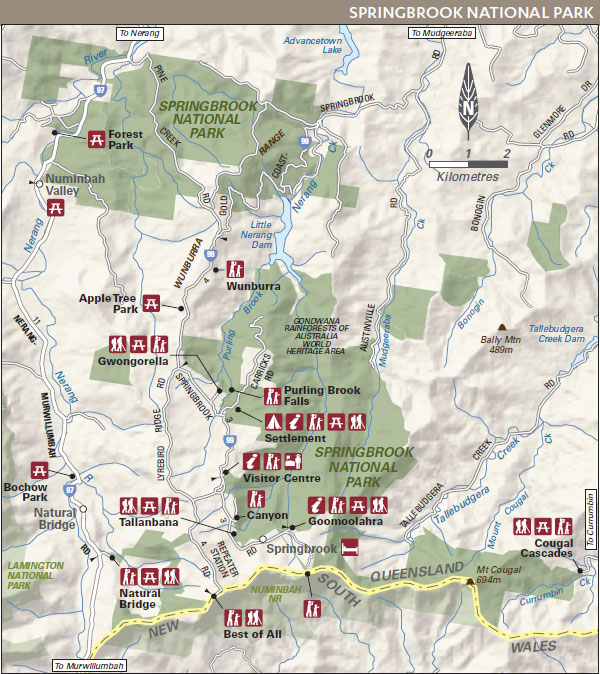

Antarctic beech evoke the atmosphere of an ancient world
PARK INFORMATION
NPRSR 13 7468
SIZE
6725 ha
LOCATION
96 km south of Brisbane; 29 km west of Mudgeeraba
ACCESS
From Brisbane via Pacific Hwy, Gold Coast–Springbrook Rd or Nerang–Murwillumbah Rd; final sections steep and winding
PERMITS
Camping permit required; fees apply; bookings essential
BEST SEASON
All seasons
VISITOR INFORMATION
Canungra (07) 5543 5156 | Surfers Paradise 1300 309 440 | www.visitscenicrim.com.au
MUST SEE, MUST DO
VISIT the Best of All Lookout for panoramic views across the border
WALK to Purling Brook Falls and go behind the falls
SEE the tiny green lights of thousands of glow-worms in the late evening at Natural Bridge
A winding drive up into the Gold Coast hinterland leads to a pristine landscape of deep valleys, plunging waterfalls and dense rainforest in which ancient Antarctic beech trees shelter. A World Heritage–listed park, Springbrook protects subtropical, warm temperate and cool temperate rainforests, open eucalypt forest and heath. In the subtropical rainforest are epiphytes, vines and strangler figs.
Springbrook National Park has four sections: the large Springbrook Plateau in the north and Numinbah in the north-west; the smaller Mount Cougal section in the southeast; and tiny Natural Bridge in the south-west.
A look at the past
The Springbrook Plateau proved a barrier to settlers and timber-getters and its forests remained largely intact throughout the 19th century. However, in 1906 it was opened up for selection and settlers moved in; by the 1920s parts of the plateau had been clear-felled. In the Natural Bridge section, timber-getters arrived in the 1870s and by the 1930s large areas of the Numinbah Valley had been cleared, paving the way for dairy farms. A sawmill was established in the Mount Cougal section in 1943, which specialised in packing-crate timber for local banana growers.
From the 1920s, sections of the region became recreation areas, scenic reserves and finally a group of national parks, which were amalgamated to become Springbrook National Park in 1990. The former Numinbah Forest Reserve was incorporated into the Numinbah section in 2008.
Aboriginal culture
Stone artefacts, rock shelters, rock art, scarred trees and earthen rings found in the park are evidence of occupation by the Yugambeh people. Their stories explain the creation of the ranges, rivers, streams and waterfalls. Dwellings constructed of bark and timber formed permanent camps in good seasons, while simpler leafy shelters were erected when life was more transient. European settlement forced the Yugambeh to move into reserves or to dwell on the fringes of the towns but today they continue to live on their traditional lands.
Natural features
Perched on top of the Springbrook Plateau, which rises from 600 to 1000 metres above sea level, the national park has the second highest rainfall in Queensland, averaging up to 3000 millimetres a year. Of the park's numerous waterfalls, the Purling Brook Falls are the most spectacular, plunging 100 metres straight down into a gorge filled with palms, tree ferns and spear lilies. Natural Bridge is a rock arch over Cave Creek, where the water plunges through a large hole into a cavern. The creek and bridge are dangerous; stay behind the fence and out of the restricted access area.
Native plants
Springbrook's rich volcanic soils support rainforests, mountain heaths and open eucalypt forests. Ancient brush box (Lophostemon confertus) overhangs some tracks. In the rainforests there are stands of Antarctic beech – some are up to 3000 years old.
Wildlife
Springbrook's diverse habitats provide refuge for a wide range of animals, some rare and endangered. Among the park's amphibious creatures are the great barred frog and the pouched frog, both frequenting the leaf-litter of Antarctic beech and surrounding rainforests. Over 100 species of birds live in the park, including Australian king-parrots, Albert's lyrebird, regent and satin bowerbirds, yellow-tailed black-cockatoos and rufous fantails. You may also see the rare Richmond birdwing butterfly flitting about. After dark a colony of tiny glow-worms lights up in the cavern at Natural Bridge.
Camping and accommodation
Camping in Springbrook is permitted at the Settlement campground only. This campsite provides well-defined camping areas with modern facilities, and is suitable for caravans and camper trailers. A camping permit is required, bookings must be made in advance and fees apply. Outside the park there are a large number of privately run campgrounds, guesthouses, lodges and B&Bs; many of these are located along or signposted off Springbrook Road.
Things to do
The park's information centre off Springbrook Road has a 100-metre boardwalk suitable for wheelchairs that leads to a lookout over the Gold Coast.
BUSHWALKING The park's numerous walking tracks range from the 600-metre-return walk to the Best of All Lookout (30 minutes, easy) to the Warrie Circuit (17 km return, 5–6 hours, difficult), which meanders through rainforest, crosses several creeks and gullies and passes orchid-clad cliffs and cascading waterfalls. The most popular walk is the Purling Brook Falls circuit (4 km return, 2–3 hours, medium difficulty), which takes you behind the waterfall and up the other side of the creek to a lookout above the falls. Natural Bridge circuit (1 km return, 1 hour, graded easy if walked in clockwise direction) is a sealed track with long sets of steps that descends through tropical rainforest to Cave Creek and on to the cavern beneath the natural arch.
PICNICKING There are tables, toilets and barbecues at Gwongorella, Goomoolahra (wheelchair access), Tallanbana and Natural Bridge picnic areas. At Goomoolahra, a 100-metre stroll leads to Goomoolahra Falls lookout, with extensive views over the rainforest valleys and beyond to Moreton Bay. At Gwongorella, a track (300 metres return) leads to lookouts over Purling Brook Falls.
SCENIC VIEWS Two of the best lookouts are at Purling Brook Falls, both of which make sure you get a bird's eye view of the rushing waters and lush rainforest below. The Best of All Lookout lives up to its name by offering spectacular views of northern New South Wales.
